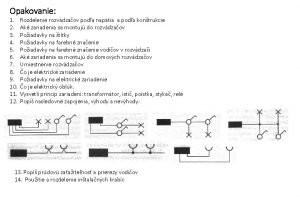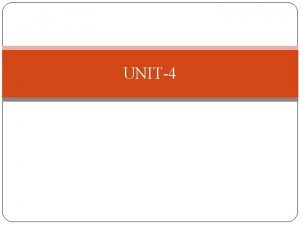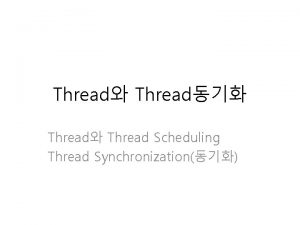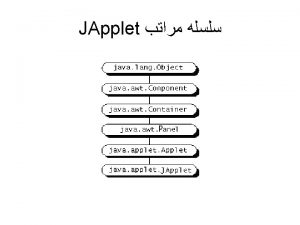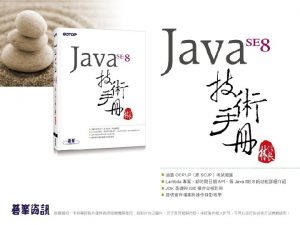start run stop Thread class My Thread extends









![六. 线程同步 public void push(char c) { data[idx]=c; idx++; } public char pop() { 六. 线程同步 public void push(char c) { data[idx]=c; idx++; } public char pop() {](https://slidetodoc.com/presentation_image_h2/f0dd70c89de437e8a533cec8c49862da/image-10.jpg)





















![八. 线程同步 问题的引出: public void push(char c) { date[idx]=c; idx++; } public pop() { 八. 线程同步 问题的引出: public void push(char c) { date[idx]=c; idx++; } public pop() {](https://slidetodoc.com/presentation_image_h2/f0dd70c89de437e8a533cec8c49862da/image-32.jpg)




![标准输入(System. in) public class P { public static void main(String[] args) { int key. 标准输入(System. in) public class P { public static void main(String[] args) { int key.](https://slidetodoc.com/presentation_image_h2/f0dd70c89de437e8a533cec8c49862da/image-37.jpg)














![1. class Point{ int x, y; public static void main(String args[]){ switch(args. length){ case 1. class Point{ int x, y; public static void main(String args[]){ switch(args. length){ case](https://slidetodoc.com/presentation_image_h2/f0dd70c89de437e8a533cec8c49862da/image-52.jpg)

![2. class Multiply { public static void main(String args[]) { Multiply m=new Multiply(); m. 2. class Multiply { public static void main(String args[]) { Multiply m=new Multiply(); m.](https://slidetodoc.com/presentation_image_h2/f0dd70c89de437e8a533cec8c49862da/image-54.jpg)
![六. 例程(对继承) class Ex 4 class Person { public static void main(String s[]) { 六. 例程(对继承) class Ex 4 class Person { public static void main(String s[]) {](https://slidetodoc.com/presentation_image_h2/f0dd70c89de437e8a533cec8c49862da/image-55.jpg)

- Slides: 56



二. 编程 start()启动线程 run()线程体,线程的实现 stop()停止线程 1. 继承Thread class My. Thread extends. Thread { public void run() { 线程体; } public static void main(String s[]) { My. Thread mt 1=new My. Thread(); My. Thread mt 2=new My. Thread(); mt 1. start(); mt 2. start(); } } 2. 实现Runnable接口 class My. Thread implements Runnable { public void run() { 线程体; } public static void main(String s[]) {My. Thread mt 1=new My. Thread(); My. Thread mt 2=new My. Thread(); Thread t 1=new Thread(mt 1); Thread t 2=new Thread(mt 2); t 1. start(); t 2. start(); } }




四. 线程的方法 Thread. current. Thread() set. Name() get. Name() set. Priority() get. Priority() Daemon: set. Daemon(true) 设置为后台线程 set. Daemon(false) 设置为应用线程

五. 例子 public class My. Thread extends Thread { private int count=0; public void set. Count() { count++; } public void run() { for (int i=0; i<10; i++) { set. Count(); System. out. println(Thread. current. Thread(). get. Name()+": "+count); } } public static void main(String[] args) { My. Thread mt 1=new My. Thread(); My. Thread mt 2=new My. Thread(); mt 1. set. Name("MT 1"); mt 2. set. Name("MT 2"); mt 1. start(); mt 2. start(); } }

五. 例子 public class My. Thread extends Thread { private static int count=0; public void set. Count() { count++; } public void run() { for (int i=0; i<10; i++) { set. Count(); System. out. println(Thread. current. Thread(). get. Name()+": "+count); } } public static void main(String[] args) { My. Thread mt 1=new My. Thread(); My. Thread mt 2=new My. Thread(); mt 1. set. Name("MT 1"); mt 2. set. Name("MT 2"); mt 1. start(); mt 2. start(); } }
![六 线程同步 public void pushchar c dataidxc idx public char pop 六. 线程同步 public void push(char c) { data[idx]=c; idx++; } public char pop() {](https://slidetodoc.com/presentation_image_h2/f0dd70c89de437e8a533cec8c49862da/image-10.jpg)
六. 线程同步 public void push(char c) { data[idx]=c; idx++; } public char pop() { idx--; return data[idx]; }



二. 常用流类 1. 字节流 File. Input. Stream / File. Output. Stream Buffered. Input. Stream / Buffered. Output. Stream Data. Input. Stream / Data. Output. Stream Piped. Input. Stream / Piped. Output. Stream 例: File. Input. Stream fis=new File. Input. Stream(“aa. doc”); Buffered. Input. Stream bis=new Buffered. Input. Stream(fis); Data. Input. Stream dis=new Data. Input. Stream(bis);

2. 字符流-16位版本的数据流 Input. Stream. Reader / Output. Stream. Writer 用于字节流 字符流的转换 Buffered. Reader / Buffered. Writer

3. 例: 从标准输入中读取字符串数据 import java. io. *; public class Input { public static void main(String[] args) { String s; Input. Stream. Reader ir; Buffered. Reader br; ir=new Input. Stream. Reader(System. in); br=new Buffered. Reader(ir); try { while((s=br. read. Line())!=null) { System. out. println("Read: "+s); } }catch(IOException e) { System. out. println("Read falled"); } } }


三. URL输入流 提供了使用统一资源定位符URL在网络上访问对象的方法. 隐含使用URL对象: image=get. Image(get. Document. Base(), ”t 1. gif”); 直接使用URL对象: URL image. Source=new URL(“http: //……”); image=get. Image(image. Source, ”t 1. gif”);






二. 编程 start()启动线程 run()线程体,线程的实现 1. 继承Thread class My. Thread extends. Thread { public void run() { 线程体; } public static void main(String s[]) { My. Thread mt 1=new My. Thread(); My. Thread mt 2=new My. Thread(); Mt 1. start(); Mt 2. start(); } } 2. 实现Runnable接口 class My. Thread implements Runnable { public void run() { 线程体; } public static void main(String s[]) {My. Thread mt 1=new My. Thread(); My. Thread mt 2=new My. Thread(); Thread t 1=new Thread(mt 1); Thread t 2=new Thread(mt 2); t 1. start(); t 2. start(); } }


1. New Thread状态 Thread my. Thread=new Thread. Class() 2. Runnable状态 Thread my. Thread=new Threadclass(); My. Thread. start();

3. Not Runnable状态 n n n sleep() wait() I/O动作时



六. 线程的方法 current. Thread() set. Name() get. Name() set. Priority() get. Priority() is. Alive() yield() set. Daemon(true) is. Daemon()

七. 例子 public class My. Thread extends Thread { private int count=0; public void set. Count() { count++; } public void run() { for (int i=0; i<10; i++) { set. Count(); System. out. println(Thread. current. Thread(). get. Name()+": "+count); } } public static void main(String[] args) { My. Thread mt 1=new My. Thread(); My. Thread mt 2=new My. Thread(); mt 1. set. Name("MT 1"); mt 2. set. Name("MT 2"); mt 1. start(); mt 2. start(); } }

五. 例子 public class My. Thread extends Thread { private static int count=0; public void set. Count() { count++; } public void run() { for (int i=0; i<10; i++) { set. Count(); System. out. println(Thread. current. Thread(). get. Name()+": "+count); } } public static void main(String[] args) { My. Thread mt 1=new My. Thread(); My. Thread mt 2=new My. Thread(); mt 1. set. Name("MT 1"); mt 2. set. Name("MT 2"); mt 1. start(); mt 2. start(); } }
![八 线程同步 问题的引出 public void pushchar c dateidxc idx public pop 八. 线程同步 问题的引出: public void push(char c) { date[idx]=c; idx++; } public pop() {](https://slidetodoc.com/presentation_image_h2/f0dd70c89de437e8a533cec8c49862da/image-32.jpg)
八. 线程同步 问题的引出: public void push(char c) { date[idx]=c; idx++; } public pop() { idx--; return date[idx]; }

解决方法: synchronized关键字



标准输出(System. out) n n System. out. print(“Hello World”); //print System. out. println(“Hello World”); //print line
![标准输入System in public class P public static void mainString args int key 标准输入(System. in) public class P { public static void main(String[] args) { int key.](https://slidetodoc.com/presentation_image_h2/f0dd70c89de437e8a533cec8c49862da/image-37.jpg)
标准输入(System. in) public class P { public static void main(String[] args) { int key. Input; int i=0; try{ while((key. Input=System. in. read())!=-1){ i++; System. out. println(i+"="+key. Input); } } catch(IOException e){} } }

标准错误(System. err) n 把错误信息显示给用户 System. err. println(“Warning!”);


2. 常用的I/O流 n File. Input. Stream/File. Output. Stream n Pipe. Input. Stream/Pipe. Output. Stream n Byte. Array. Input. Stream/ Byte. Array. Output. Stream n Sequence. Input. Stream n String. Buffer. Input. Stream

3. 过滤流 Filter. Input. Stream/Filter. Output. Stream

三. URL输入流 提供了使用统一资源定位符URL在网络上访 问对象的方法. 隐含使用URL对象: image=get. Image(get. Document. Base(), ”t 1. gif ”); 直接使用URL对象: URL image. Source=new URL(“http: //……”); image=get. Image(image. Source, ”t 1. gif”);








1. 定义一个日期类Date class Date { private int year=1990, month=1, day=1; public Date(){} public Date(int year, int month, int day) { this. year=year; this. month=month; this. day=day; } public Date(int year) { this(year, 1, 1); } public Date(Date d) { this (d. year, d. month, d. day); } public String get. Date() { return year+"/"+month+"/"+day; } public void set. Date(int year, int month, int day) { this. year=year; this. month=month; this. day=day; } public void set. Date(int month, int day) { set. Date(this. year, month, day); } } class Ex 3 { public static void main(String[] args) { Date d 1=new Date(); System. out. println(d 1. get. Date()); Date d 2=new Date(2000, 11, 17); System. out. println(d 2. get. Date()); Date d 3=new Date(2010); System. out. println(d 3. get. Date()); Date d 4=new Date(d 2); System. out. println(d 4. get. Date()); Date d 5=d 2; System. out. println(d 5. get. Date()); } }

![1 class Point int x y public static void mainString args switchargs length case 1. class Point{ int x, y; public static void main(String args[]){ switch(args. length){ case](https://slidetodoc.com/presentation_image_h2/f0dd70c89de437e8a533cec8c49862da/image-52.jpg)
1. class Point{ int x, y; public static void main(String args[]){ switch(args. length){ case 0: Point p=new Point(); p. display(); break; case 1: Point p 1=new Point(Integer. parse. Int(args[0])); p 1. display(); break; case 2: Point p 2=new Point(Integer. parse. Int(args[0]), Integer. parse. Int(args[1])); p 2. display(); break; default: System. out. println(“the arguments too long”); } //switch

public Point(int x, int y){ this. x=x; this. y=y; } public Point(int x){ this(0, x); } public Point(){ this(0); } public void display(){ System. out. println("("+x+", "+y+")"); } } //class
![2 class Multiply public static void mainString args Multiply mnew Multiply m 2. class Multiply { public static void main(String args[]) { Multiply m=new Multiply(); m.](https://slidetodoc.com/presentation_image_h2/f0dd70c89de437e8a533cec8c49862da/image-54.jpg)
2. class Multiply { public static void main(String args[]) { Multiply m=new Multiply(); m. ply(Integer. parse. Int(args[0])); } public void ply (int i) { int s=1; for (int j=i; j>0; j--) {s*=j; } System. out. println(s); } }
![六 例程对继承 class Ex 4 class Person public static void mainString s 六. 例程(对继承) class Ex 4 class Person { public static void main(String s[]) {](https://slidetodoc.com/presentation_image_h2/f0dd70c89de437e8a533cec8c49862da/image-55.jpg)
六. 例程(对继承) class Ex 4 class Person { public static void main(String s[]) { private String name; { Person p 1=new Person("Zhao", true); private boolean sex; p 1. get. Detail(); public Person(String name, boolean sex) Teacher t 1=new Teacher("Qian", false, 1); { this. name=name; t 1. get. Detail(); this. sex=sex; } Person p[]=new Person[5]; public void get. Detail() p[0]=new Teacher("Sun", true, 2); { System. out. println(name+sex); } p[1]=new Student("Li", true, 2); } p[2]=new Teacher("Zhou", true, 2); class Teacher extends Person p[3]=new Student("Wu", true, 2); { private int department; p[4]=new Teacher("Zheng", true, 2); public Teacher(String name, boolean sex, int depart) for (int i=0; i<p. length; i++) { super(name, sex); { if(p[i] instanceof Teacher) department=depart; } { System. out. println("Teacher"); public void get. Detail() p[i]. get. Detail(); } { super. get. Detail(); else if (p[i] instanceof Student) System. out. println(department); { System. out. println("student"); } Student s 1=(Student)p[i]; } s 1. get. Detail(); } class Student extends Person } { 同Teacher department-->classes } depart-->cls } }

import java. awt. *; …… public class Calculator pan. add(new Button("/")); { Frame f; f. set. Size(200, 200); Panel pan; f. set. Visible(true); } public Calculator () public static void main(String s[]) { f=new Frame("Calculator"); { pan=new Panel(); } c. go(); public void go() { f. add("North", new Text. Field("")); f. add("Center", pan); pan. set. Layout(new Grid. Layout(4, 4)); pan. add(new Button("1")); pan. add(new Button("2")); pan. add(new Button("+")); Calculator c=new Calculator (); } }
 Class cthread extends thread
Class cthread extends thread Extends testcase
Extends testcase Jframe image
Jframe image Weirdx
Weirdx Parameterized thread start
Parameterized thread start Aperture stop
Aperture stop One stop teacher stop
One stop teacher stop Short run equilibrium
Short run equilibrium Run lola run themes
Run lola run themes Run lola run editing techniques
Run lola run editing techniques Short run vs long run economics
Short run vs long run economics Within run and across run meaning
Within run and across run meaning Perfect competition short run
Perfect competition short run Brigitta olsen
Brigitta olsen Nnlolas
Nnlolas Teco plc
Teco plc Zapojenie stykaca schema
Zapojenie stykaca schema Kiss keep improve start stop
Kiss keep improve start stop Start stop continue examples
Start stop continue examples Diagramma di flusso scuola primaria
Diagramma di flusso scuola primaria How to stop worrying and start living rules
How to stop worrying and start living rules Links rechts schakeling
Links rechts schakeling Stop start continue examples
Stop start continue examples Paths start and stop at
Paths start and stop at Omnilore
Omnilore Repulsion start induction run motor
Repulsion start induction run motor Repulsion start induction run motor
Repulsion start induction run motor It's gotta start somewhere it's gotta start sometime
It's gotta start somewhere it's gotta start sometime Triage protocol
Triage protocol Extends and implements difference
Extends and implements difference How to make pochampally sarees
How to make pochampally sarees Case scenario examples
Case scenario examples Case diagram
Case diagram Pancreas location quadrant
Pancreas location quadrant Welcome to netherlands a tiny country
Welcome to netherlands a tiny country Thermosphere
Thermosphere Median cricothyroid ligament
Median cricothyroid ligament Runtimeexception extends exception
Runtimeexception extends exception Introduction to use case diagram
Introduction to use case diagram Extends jframe java
Extends jframe java Scottie dog lumbar spine
Scottie dog lumbar spine Extends vs includes use case
Extends vs includes use case A straight path that has no thickness and extends forever
A straight path that has no thickness and extends forever It is a relief that barely extends past the base
It is a relief that barely extends past the base Bap coverage extends to mobile equipment as long as it is
Bap coverage extends to mobile equipment as long as it is Temporalis
Temporalis Uml extends
Uml extends Extends jframe implements actionlistener
Extends jframe implements actionlistener What is polymorphism
What is polymorphism Java extends
Java extends Today's class was amazing
Today's class was amazing Package mypackage class first class body
Package mypackage class first class body Difference between abstract class and concrete class
Difference between abstract class and concrete class What is modal class
What is modal class Class i vs class ii mhc
Class i vs class ii mhc Difference between abstract class and concrete class
Difference between abstract class and concrete class Frequency distribution
Frequency distribution
















